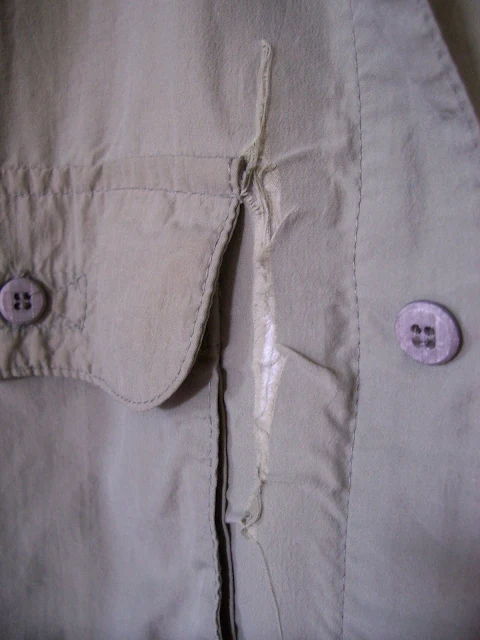My sewing kit is small. So small that it fits into a plastic container that used to have dental floss in it. A tailor I am not.
But I do what I can to keep my small, functional wardrobe wearable for as long as possible.
As a result, I could write the "Clothing Repair for Dummies" version of the popular series.
Here are some recent examples from our research in the Not Buying Anything Clothing Repair for Dummies Workshop.
Lose a button? Safety pins are an alternative that can work.
Temporarily.
Or permanently.
I am an experienced clothing repair dummy, so it's mostly permanent in my case.
Tear in your 100% polyester shirt?
I used the must have item from every Macgyverer's toolkit - duct tape - to fashion a repair.
I rebranded a small strip as an Easily Applicable Adhesive Patch.
Results may vary, but why not try it if it extends the usefulness of something?
 |
| Easily applicable adhesive patch placed on the inside torn section of shirt. |
Wearing a hole in the heel of one of a pair of cotton socks presents a challenge.
It's a small flaw to doom a pair of otherwise wearable socks to the rag bag, or compost.
Don't throw that pair of socks out yet.
 |
| Turn that sock frown upside down. |
I discovered the easiest "just for dummies" fix ever.
Flip the sock over so the hole is at the top. On the top of the ankle the sock wrinkles and closes up.
What hole?
On your heel, where all the action is, you are covered.
 |
| Not really a smile. More like a smirk. |
I will learn to sew and do my own repairs the way they have been done for thousands of years.
It would also be good to have a sewing machine, and know how to use it without losing a finger.
Until then I will continue to use the NBA approved dummy method, and look forward to upgrading my tiny sewing repair kit, and the skills required to use it.
Having a repair issue with with a "fibre and textile material that is worn for style, safety, and protection from the elements"?
Want to fix it properly and are not sure how?
Learn more at this iFixit Clothing Repair page.



I still darn socks. I paid a dime for a cue ball at a garage sale a couple decades ago - it's the perfect form to slip into almost any size sock for darning. Being five foot and a smidge tall - and being that the world of fashion somewhere along the way decided that being five-foot-four made one petite - I have become a genius at hemming things with fabric glue. Find a hole in your favourite sweater? Pour out the jar of coloured buttons you bought for 50 cents/pound at the thrift store ages ago, find a few that look rather artistic when grouped together (odd numbers work best - the old "nature abhors symmetry" thing) , stitch them on - starting with one covering the hole that started this whole process - arrange the rest with either artsy randomness or in a pattern - put a dot of fabric glue over the stitches so you'll never have to do it again - enjoy wearing your sweater for another X number of years. My sewing kit is a little bigger than yours - one of those blue Danish cookie tins people tend to give for Christmas. And I think whoever invented the safety pin should have won a Nobel Prize.
ReplyDeleteWe like your creative fixes that honour and enhance the clothing. Safety pins are appreciated in India where "pins are kept over generations and passed down to daughters."
DeleteGregg, this post was hilarious!! But lots of good advice as I have known people to throw out a perfectly good shirt for want of button-sewing skills.
ReplyDeleteI love the book Darning Repair Make Mend by Hikaru Noguchi for inspiration. It really helped me to learn the sort of creative mending I can do on work clothes and still be presentable.
My family gave me some wonderful darning tools for my birthday last year, including a beautiful English Ash spindle made for darning the fingers of gloves. You can improvise of course, but I find the job much easier with the correct tool and they will last my lifetime and more.
Don't be frightened of the sewing machine! I taught myself the basics years ago and it has saved me thousands of dollars as well as saving textiles from landfill. It was especially handy for making and lining curtains and household items.
Madeleine
"Thousands of dollars". You've got my attention. The Noguchi book sounds "darn" interesting. Thanks for the recommendation.
Delete- Gregg
When my boyfriend's cotton socks get too many holes in them to repair comfortably, I cut the foot of the sock off and use the leg and cuff part as sweat wrist bands. We repair clothing as much as possible too, of course! Great post and pictures, thanks! - Mary
ReplyDeleteI do that with most of my clothes and always with my socks when they get holes. I just sew the holes up and the socks are good as new. Same with shirts or pants that get holes. I grab a needle and hand sew whatever needs to be sewn back together. When t shirts finally get threadbare and full of holes I cut them up into cleaning rags.
ReplyDelete